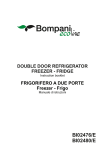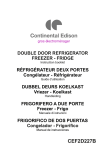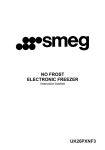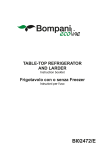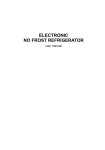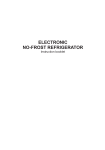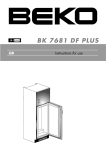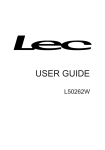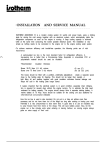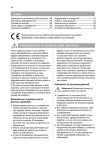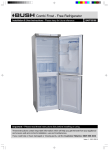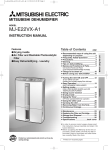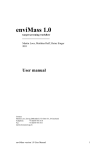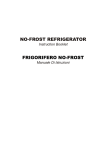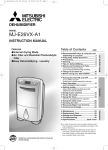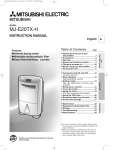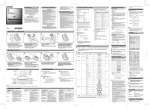Download Manuale - Bompani
Transcript
DOUBLE DOOR REFRIGERATOR FREEZER - FRIDGE Instruction booklet FRIGORIFERO A DUE PORTE Freezer - Frigo Manuale di istruzioni Contents BEFORE USING THE APPLIANCE ........................................................ 2 Safety Instructions .............................................................................................2 Safety warnings ..................................................................................................3 Installing and Operating your Fridge ...................................................................4 Before Using your Fridge ....................................................................................4 THE VARIOUS FUNCTION AND POSSIBILITIES .................................. 5 Thermostat Setting .............................................................................................5 Accessoires .......................................................................................................5 Ice tray ..................................................................................................................... 5 ARRANGING FOOD IN THE APPLIANCE .............................................. 6 Refrigerator Compartment ...................................................................................6 Freezer Compartment ........................................................................................6 CLEANING AND MAINTENANCE ........................................................... 7 Defrosting ...........................................................................................................8 Replacing The Light Bulb ....................................................................................9 SHIPMENT AND REPOSITIONING ........................................................9 Repositioning the Door .......................................................................................9 BEFORE CALLING YOUR AFTER SALES SERVICE .......................... 10 THE PARTS OF THE APPLIANCE AND THE COMPARTMENTS ....... 12 EN - 1 - PART - 1. BEFORE USING THE APPLIANCE Safety Instructions • If the model contains R600a-see name plate under refrigerant (the coolant isobutane), naturals gas that, is very environmentally friendly but also combustible. When transporting and installing the unit care must be taken to ensure that none of the refrigeration circuit components become damaged. In the event of damage avoid naked flames or ignition sources and ventilate the room in which the unit is placed for a few minutes. Warning: Keep ventilation openings in appliance enclosure or in structure for building in, clear of obstruction. • Do not use mechanical devices or other artificial means to accelerate the defrosting process. • Do not use electrical appliances in the refrigerator or freezer compartment of the appliance. • If this appliance is to replace an old refrigerator with a lock; break or remove the lock as a safety measure before storing it, to protect children while playing might lock themselves inside. • Old refrigerators and freezers contain insulation gases and refrigerant, which must be disposed of properly. Entrust the disposal of a scrap unit categorically to competence of your local waste disposal service and contact your local authority or your dealer if you have any questions. Please ensure that the pipe of work of your refrigerating unit does not get damaged prior to being picked-up by the relevant waste disposal service. Important note: Please read this booklet before installing and switching on this appliance. The manufacturer assumes no responsibility for incorrect installation and usage as described in this booklet. Please ask your municipal authority about the disposal of the WEEE for the reuse, recycle and recovery purposes. EN - 2 - Safety warnings Warning: Do not use mechanical devices or other means to accelerate the defrosting process, other than those recommended by the manufacturer. Do not use electrical appliances inside the food storage compartments of the appliance, unless they are of the type recommended by the manufacturer. Keep ventilation openings, in the appliance enclosure or in the built-in structure, clear of obstruction. Do not damage the refrigerant circuit. • Do not use multiple receptacles or extension cord. • Do not plug in damaged, torn or old plugs. • Do not pull, bend or damage the cord. • This appliance is designed for use by adults, do not allow children to play with the appliance or let them to hang over the door. • Do not plug-in or out the plug from the receptacle with wet hands to prevent electrocution! • Do not place glass bottles or beverage cans in the freezer department. Bottles or cans may explode. • Do not place explosive or flammable material in your fridge for your safety. Place drinks with higher alcohol amount vertically and by closing their necks tightly in the fridge department. • When taking ice made in the freezer department, do not touch it, ice may cause iceburns and/or cuts. • Do not touch frozen goods with wet hands! Do not eat ice-cream and ice cubes immediately after you take them out of the freezer department! • Do not re-freeze the frozen goods after being melted. This may cause health issues like food poisoning. • Do not cover the body or top of fridge with lace. This effects the performance of your fridge. • Fix the accessories in the fridge during transportation to prevent damage to accessories. • The appliance is not intended for use by people (including children) with reduced physical, sensory or mental capabilities, or lack of experience and knowledge, unless they have been given supervision or instruction concerning use of the appliance by a person responsible for their safety. Children should be supervised to ensure that they don’t play with the appliance. • If the supply cord is damaged it must be replaced by the manufacturer or service agent or similary qualified people in order to avoid a hazard. EN - 3 - Installing and Operating your Fridge • Before making the connection to the power supply, ensure that the voltage on the nameplate corresponds to the voltage of electrical system at your home. • Operating voltage for your fridge is 220-240 V at 50Hz. • Mains cord of your fridge has a grounded plug. This plug should be used with a grounded receptacle that has a 16 amper fuse minimum. If you don’t have a receptacle confirming with this, please have it done by a qualified electirician. • We do not take the responsibility of the damages that occur due to ungrounded usage. • Place your fridge in a place that it would not be exposed to direct sunlight. • Your appliance should be at least 50 cm away from stoves, ovens and heater cores, and should be at least 5 cm away from electrical ovens. • It should never be used outdoors or left under the rain. • Fit the plastic wall spacers to the condenser at the back of the refrigerator in order to prevent cleaning to the wall for good performance. • When your fridge is placed next to a deep freezer, there should be at least 2 cm between them to prevent humidity on the outer surface. Do not place anything on your fridge, and install your fridge in a suitable place so that at least 15 cm is available on the upper side. • If you will place your fridge next to your kitchen cabinets, leave a space of 2 cm between them. • Install the distance adjustment plastic (the part with black vanes at the rear) by turning it 90° to prevent the condenser from touching the wall. • The adjustable front legs should stabilized in an appropriate height to allow your fridge operate in a stable and proper way. You can adjust the legs by turning them clockwise (or in the opposite direction). This should be done before placing food in the fridge. • Before using your fridge, wipe all parts with warm water added with a tea spoonful of sodium bicarbonate, and then rinse with clean water and dry. Place all parts after cleaning. Before Using your Fridge • When it is operated for the first time or after transportation, keep your fridge in the upright position for 3 hours and plug it on to allow efficient operation. Otherwise, you may damage the compressor. • Your fridge may have a smell when it is operated for the first time; the smell will fade away when your fridge starts to cool. EN - 4 - PART - 2. THE VARIOUS FUNCTION AND POSSIBILITIES Thermostat Setting • Thermostat automatically regulates the inside temperature of the refrigerator compartment and freezer compartment.By rotating the knob from position 1 to 5, colder temperatures can be obtained. «0» position shows thermostat is closed and no cooling will be avaible. • For short-term storage of food in the freezer compartment, you can set the knob between 1 and 3 position. • For long-term storage of food in the freezer compartment, you can set knop 3-4 position. Note that ; the ambiant temperature, temperature of the freshly stored food and how often the door is opened, affects the temperature in the refrigerator compartment. If required,change the temperature setting. Accessoires Ice tray • Fill the ice tray with water and place in freezer compartment. • After the water completely turned into ice, you can twist the tray as shown below to get the ice cube. EN - 5 - PART - 3. ARRANGING FOOD IN THE APPLIANCE Refrigerator Compartment • To reduce humidity and consequent increase of frost never place liquids in unsealed containers in the refrigerator. Frost tends to concentrate in the coldest parts of the evaporator and in time will require more frequent defrosting. • Never place warm food in the refrigerator. Warm food should be allowed to cool at room temperature and should be arranged to ensure adequate air circulation in the refrigerator compartment. • Nothing should touch on the back wall as it will cause frost and the packages can stick on the back wall. Do not open the refrigerator door too frequently. • Arrange the meat and cleaned fish(wrapped in packages or sheets of plastic) which you will use in 1-2 days,in the bottom section of the refrigerator compartment(that is above the crisper) as this is the coldest section and will ensure the best storing conditions. • You can put the fruits and vegetables into crisper without packing. Freezer Compartment • The use of freezer is, storing of deep-frozen or frozen foods for long periods of time and making ice cubes. • To freeze fresh food, ensure that as much of the surface as possible of food to be frozen is in contact with the cooling surface. • Do not put fresh food with frozen on side by side as it can thaw the frozen food. • While freezing fresh foods(i.e meat,fish and mincemeat), divide them in parts you will use in one time. • Once the unit has been defrosted replace the foods into freezer and remember to consume them in as short period of time. • Never place warm food in the freezer compartment. As it will disturb the frozen foods. • For storing the frozen foods;the instructions shown on frozen food packages should always be followed carefully and if no information is provided food should not be stored for more than 3 months from the purchased date. • W hen buying frozen foods ensure that these have been frozen at suitable temperatures and that the packing is intact. • Frozen foods should be transported in appopriate containers to maintain the quality of the food and should be returned to the freezing surfaces of the unit in the shortest possible time. • If a package of frozen food shows the sign of humidity and abnormal swelling it is probable that it has been previously stored at an unsuitable temperature and that the contents have deteriorated. • The strorage life of froozen foods depends on the room temperature, thermostat setting, how often the door is opened, the type of food and the length of time required to transport the product from the shop to your home. Always follow the instruductions printed on the package and never exceed the maximum storage life indicated. Not that; if you want to open again immediately after closing the freezer door, it will not be opened easily. It’s quite normal! After reaching equilibrium condition, the door will be opened easily. EN - 6 - PART - 4. CLEANING AND MAINTENANCE • Make sure to unplug the fridge before starting to clean it. • Do not wash your fridge by pouring water. • You can wipe the inner and outer sides with a soft cloth or a sponge using warm and soapy water. • Remove the parts individually and clean with soapy water. Do not wash in washing machine. • Never use flammable, explosive or corrosive material like thinner, gas, acid for cleaning. • You should clean the condenser with broom at least once a year in order to provide energy saving and increase the productivity. Make sure that your fridge is unplugged while cleaning. EN - 7 - Defrosting Refrigerator Compartment; • Defrosting occurs automatically in refrigerator compartment during operation ; the defrost water is collected by the evaporating tray and evoparates automatically. • The evaporating tray and the defrost water drain hole should be cleaned periodically with defrost drain plug to prevent the water from collecting on the bottom of the refrigerator instead of flowing out. • You can also pour 1/2 glass of the water to drain hole to clean inside. Freezer Compartment; The frost, accumulated in the freezer compartment, should be removed periodically. (Use the plastic scraper provided) The freezer compartment should be cleaned in the way as the refrigerator compartment, with the defrost operations of the compartment at least twice a year. For this; • The day before you defrost, set the thermostat dial to “5” position to freeze the foods completely. • During defrosting, frozen foods should be wrapped in several layers of paper and kept in a cool place. The inevitable rise in temperature will shorten their storage life. Remember to use these foods within a relatively short period of time. • Set thermostat knob to position « 0 » or unplug the unit; leave the door open until completely defrosted. • To accelerate the defrosting process one or more basins of warm water can be placed in the freezer compartment. • Dry the inside of the unit carefully and set the thermostat knob to MAX position. EN - 8 - Replacing The Light Bulb To replace the bulb in freezer and fridge departments; 1- Unplug your fridge. 2- Remove the cover of the box from the claws using a screwdriver. 3- Replace with a bulb of maximum 15 Watts. 4- Install the cover. 5- Wait for 5 minutes before re-plugging and bring the thermostat to its original position. PART - 5. SHIPMENT AND REPOSITIONING • Original package and foam may be kept for re-transportation (optionally). • You should fasten your fridge with thick package, bands or strong cords and follow the instructions for transportation on the package for re-transportation. • Remove movable parts (shelves, accessories, vegetable bins etc.) or fix them into the fridge against shocks using bands during re-positioning and transportation. • Carry your fridge in the upright positio. Repositioning the Door ( For Some Models) You can reposition the doors of your fridge. Contact nearest Authorized service for this. EN - 9 - PART - 6. BEFORE CALLING YOUR AFTER SALES SERVICE If your refrigerator is not working properly,it may be a minor problem, therefore check the following, before calling an electrician to save time and money. What to do if your refrigerator does not operate ; Check that ; • There is no power , • The general switch in your home is disconnected , • The thermostat setting is on« 0 »position , • The socket is not sufficient. To check this, plug in another appliance that you know which is working into the same socket. What to do if your refrigerator performs poorly ; Check that ; • You have not overloaded the appliance , • The doors are closed perfectly , • There is no dust on the condenser , • There is enough place at the rear and side walls. If there is noise ; The cooling gas which circulates in the refrigerator circuit may make a slight noise(bubbling sound) even when the compressor is not running. Do not worry this is quite normal. If these sounds are different check that ; • The appliance is well leveled • Nothing is touching the rear. • The stuffs on the appliance are vibrating. If there is water in the lower part of the refrigerator ; Check that ; The drain hole for defrost water is not clogged(Use defrost drain plug to clean the drain hole) EN - 10 - If your fridge is not cooling enough; Your fridge is designed to operate in the ambient temperature intervals stated in the standards, according to the climate class stated in the information label. We do not recommend operating your fridge out of stated temperatures value limits in terms of cooling effectiveness. Climate Class T ST N SN Ambient Temperature (°C) Between 16 and 43 (°C) Between 16 and 38 (°C) Between 16 and 32 (°C) Between 10 and 32 (°C) Recommendations • In order to increase space and improve the appearance,the « cooling section » of this appliance is positioned inside the back wall of the refrigerator compartment. When the appliance is running, this wall is covered with frost or water drops,according to weather the compressor is running or not. Do not worry. This is quite normal. The appliance should be defrosted only if an excessively thick layer forms on the wall. • If the appliance is not used for long time (for example during the summer holidays)Defrost and clean the refrigerator leaving the door open to prevent the formation of midew and smell. • To stop the appliance completely, unplug from main socket (for cleaning and when the doors are left open) Conformity Information • Tropical Class is defined for the environment temperatures between 16°C and 43°C in accordance with the TS EN ISO 15502 Standards. • The appliance is designed in compliance with the EN15502, IEC60335-1 / IEC60335-2-24, 2004/108/EC standards. EN - 11 - THE PARTS OF THE APPLIANCE AND THE COMPARTMENTS PART - 7. 1 11 2 10 A 9 B 8 3 4 5 7 6 This presentation is only for information about the parts of the appliance. Parts may vary according to the appliance model. A) FREEZER COMPARTMENT B) REFRIGERATOR COMPARTMENT 6) LEVVELING FEET 7) BOTTLE SHELF 8) BUTTER CHEESE SHELF 9) BUTTER CHEESE SHELF COVER 10) EGG HOLDER 11) THERMOSTAT BOX 1) ICE TRAY 2) FREEZER SHELF 3) REFRIGERATOR SHELF 4) CRISPER COVER 5) CRISPER EN - 12 - Indice PRIMA DI USARE L’APPARECCHIO.....................................................14 Istruzioni per la sicurezza ................................................................................ 14 Avvertenze ........................................................................................................ 15 Installazione ed accensione dell’apparecchio .................................................. 16 Prima di accendere .......................................................................................... 16 FUNZIONI E POSSIBILITA’ ................................................................... 17 Impostazione termostato .................................................................................. 17 Accessori .........................................................................................................17 Vassoio per il ghiaccio .......................................................................................... 17 SISTEMAZIONE DEL CIBO NEL FRIGORIFERO ............................... 18 Scomparto Frigo ............................................................................................... 18 Scomparto Freezer ........................................................................................... 18 PULIZIA E MANUTENZIONE ................................................................. 19 Sbrinamento ..................................................................................................... 20 Sostituzione della lampadina ........................................................................... 21 TRASPORTO E SPOSTAMENTO DELL’APPARECCHIO ................... 21 Modifica del senso di apertura della porta ........................................................ 21 PRIMA DI CHIAMARE IL SERVIZIO ASSISTENZA ............................... 22 COMPONENTI DELL’ELETTRODOMESTICO E SCOMPARTI ......... 24 IT - 13 - PARTE 1. PRIMA DI USARE L’APPARECCHIO Istruzioni per la sicurezza • Questo modello può contenere R600a, vedere la piastra sotto il refrigerante, (isobutano refrigerante), gas naturale che non è inquinante per l’ambiente, ma infiammabile. Durante il trasporto e l'installazione dell'apparecchio è necessario porre particolare attenzione affinché non venga danneggiato alcun componente del circuito di refrigerazione. In caso di danneggiamento tenere lontana qualsiasi fonte di possibile incendio e far ventilare per diversi minuti la stanza nella quale è posizionato l’apparecchio. • Non utilizzare dispositivi meccanici o qualsiasi mezzo non naturale per accellerare il processo di sbrinamento • Non utilizzare apparecchi elettrici all’interno del frigorifero. • Se questo apparecchio sostituisce un vecchio frigorifero munito di chiusura, rompere o rimuovere questa chiusura come misura di sicurezza prima di immagazzinare il vecchio apparecchio, per proteggere i bambini che potrebbero rimanervi rinchiusi durante i loro giochi • I vecchi frigoriferi ed i freezer contengono gas isolanti e refrigeranti che devono essere smaltiti adeguatamente. Affidare lo smaltimento dell’apparecchio vecchio solamente alla locale discarica e contattare l’autorità locale o il rivenditore in caso di dubbio. Assicurarsi che la serpentina del vostro frigorifero non venga danneggiata prima di essere affidata alla discarica locale di competenza. IMPORTANTE: Vi preghiamo di leggere questo manuale prima di installare ed accendere l’apparecchio. Il produttore non si assume alcuna responsabilità se l’installazione e l’utilizzo dell’apparecchio non sono conformi a quanto descritto in questo manuale. Questo apparecchio dispone di contrassegno ai sensi della direttiva europea 2002/96/CE in materia di apparecchi elettrici ed elettronici (waste electrical and electronic equipment - WEEE). Questa direttiva definisce le norme per la raccolta e il riciclaggio degli apparecchi dismessi valide su tutto il territorio dell'Unione Europea. IT - 14 - Avvertenze Attenzione: non usare dispositivi meccanici o altri strumenti artificiali per accellerare il processo di sbrinamento. Non usare dispositivi elettrici nello scomparto di conservazione cibi del dispositivo. Tenere libere le aperture di ventilazione del dispositivo. Non danneggiare il circuito refrigerante del frigo. • Non utilizzare adattatori o derivazioni che potrebbero causare surriscaldamento o incendio. • Non inserire cavi di alimentazione vecchi o attorcigliati. • Non torcere o piegare i cavi. • Non permettere ai bambini di giocare con l’apparecchio. I bambini non devono MAI sedersi sui ripiani o sui cassetti o appendersi alla porta. • Non utilizzare oggetti metallici appuntiti per togliere il ghiaccio dallo scomparto freezer; potrebbero forare il circuito di refrigerazione e causare un irreparabile danno all’apparecchio. Utilizzare il raschietto in plastica in dotazione con l’apparecchio. Non non collegare l'apparecchio all’alimentazione con le mani bagnate • Non mettere nel freezer contenitori di liquidi (bottiglie di vetro o lattine), specialmente se contengono liquidi gassati che potrebbero provocare lo scoppio del contenitore durante il congelamento. • Le bottiglie contenenti liquidi ad alta percentuale alcolica devono essere chiuse ermeticamente e inserite nel frigorifero in posizione verticale. • Non toccare le superfici refrigeranti, specialmente con le mani bagnate perché vi potreste provocare ustioni o ferite. • Non mangiare il ghiaccio appena tolto dal freezer. • Questo apparecchio non deve essere usato da persone (inclusi i bambini) con capacità fisiche, sensoriali o mentali ridotte, o che mancano di esperienza e conoscenza, a meno che non abbiano ricevuto una supervisione o istruzioni sull’uso dell’apparecchio da parte di una persona responsabile della loro sicurezza. I bambini devono ricevere supervisione per assicurarsi che non giochino con l’apparecchio. • Se il cavo di alimentazione viene danneggiato, deve essere sostituito dal produttore o da un tecnico per l’assistenza o una persona addetta. IT - 15 - Installazione ed accensione dell’apparecchio • Questo apparecchio funziona a 220-240V oppure a 200-230V 50 Hz. Vi preghiamo di controllare la targhetta dell’apparecchio e di accertarvi che lo stesso sia compatibile con la vostra tensione elettrica • Prima di effettuare il collegamento all’alimentazione, assicurarsi che la tensione indicata sulla targhetta corrisponda a quella della vostra abitazione. • Inserire la spina in una presa dotata di adeguata messa a terra. Se la presa non dispone di messa a terra o la spina non si inserisce correttamente, consigliamo di rivolgersi ad un elettricista esperto per ottenere assistenza. • La spina deve essere accessibile anche dopo il posizionamento dell’apparecchio. • Il produttore non è responsabile del mancato collegamento a terra, come descritto in questo manuale. • Non posizionare l’apparecchio con esposizione alla luce del sole. • Non usare all’aperto il prodotto, l’apparecchio non deve essere esposto alla pioggia. • Posizionare il frigorifero lontano da fonti di calore e in una sede ben ventilata. Il frigorifero deve distare almeno 50 cm da radiatori, stufe a gas o a carbone e 5 cm da stufe elettriche. • La sommità del frigorifero deve disporre di uno spazio libero di 15 cm. • Non mettere oggetti, soprattutto se pesanti, sul frigorifero. • Se l’apparecchio viene posizionato vicino ad un altro frigorifero o ad un freezer, mantenere una distanza minima di 2 cm. per evitare la condensa. • Applicare i distanziatori in plastica alla serpentina sulla parte posteriore del frigorifero in modo che non si appoggi alla parete assicurando il buon funzionamento. • L’apparecchio deve essere posizionato stabilmente sul pavimento. Utilizzare i due piedini frontali regolabili per compensare l’eventuale dislivello del pavimento. • La pulizia dell’esterno dell’apparecchio e dei suoi accessori interni deve essere effettuata con una soluzione di acqua e sapone liquido; l’interno dell’apparecchio deve essere pulito con bicarbonato di sodio disciolto in acqua tiepida. Asciugare tutto prima di reinserire gli accessori. Prima di accendere • Attendere 3 ore prima di inserire la spina dell’apparecchio nella presa per assicurare un perfetto funzionamento. • Al momento dell’accensione l’apparecchio potrebbe emanare sgradevole, odore che scomparirà non appena l’apparecchio inizia a raffreddarsi. IT - 16 - PARTE 2. FUNZIONI E POSSIBILITA’ Impostazione termostato • Il termostato regola automaticamente la temperatura interna degli scomparti frigorifero e freezer. Ruotando la manopola dalla posizione 1 alla 5, la temperatura può essere progressivamente raffreddata. La posizione “0” indica la chiusura del termostato e la mancata refrigerazione. • Per la conservazione a breve termine del cibo nello scomparto freezer, posizionare la manopola tra 1 e 3 • Per la conservazione a lungo termine del cibo nello scomparto freezer, posizionare la manopola da 3 a 4. Avvertenza: la temperatura dello scomparto frigo può essere alterata dalla temperatura ambiente, dalla temperatura del cibo appena inserito e dal numero di volte che la porta viene aperta. Se necessario, modificare la regolazione della temperatura. Accessori Vassoio per il ghiaccio • Riempire il vassoio di acqua ed inserirlo nello scomparto freezer. • Una volta che l’acqua si è trasformata in ghiaccio, è possibile agire sul vassoio come sotto indicato per far fuoriuscire i cubetti. IT - 17 - PARTE 3. SISTEMAZIONE DEL CIBO NEL FRIGORIFERO Scomparto Frigo • Per ridurre l’umidità ed il conseguente aumento di brina non inserire mai nel frigorifero liquidi in contenitori aperti. La brina tende a concentrarsi nelle parti più fredde dell’evaporatore e questo richiederebbe col passare del tempo operazioni di sbrinamento sempre più frequenti. • Non inserire mai nel frigorifero cibo caldo. Il cibo ancora caldo deve essere lasciato raffreddare a temperatura ambiente e deve disporre di un’adeguata circolazione d’aria nello scomparto frigo. • Assicurarsi che niente sia posto a contatto con la parete posteriore poiché ciò potrebbe causare brina e gli oggetti potrebbero attaccarsi alla parete. Non aprire la porta del frigorifero con troppa frequenza. • Sistemare la carne ed il pesce pulito (impacchettati o avvolti in fogli di plastica), da usarsi entro 1-2 giorni, nella parte inferiore dello scomparto frigo (che si trova sopra lo scomparto frutta e verdura) poiché questa è la parte più fredda che assicura le migliori condizioni di conservazione. • La frutta e la verdura possono essere inserite nel loro scomparto senza essere impacchettate. Scomparto Freezer • Il freezer viene utilizzato per la conservazione per un lungo periodo di tempo di cibi surgelati o congelati e per la conservazione dei cubetti di ghiaccio. • Per congelare il cibo fresco, assicurarsi che la maggior parte della superficie del cibo da congelare sia in contatto con la superficie raffreddante. • Non mettere il cibo fresco a contatto con quello congelato in quanto questo potrebbe provocare lo scongelamento del cibo già congelato. • Quando desiderate congelare del cibo fresco (ad es. carne, pesce, carne trita), suddividetelo in porzioni da usarsi di volta in volta. • Quando l’apparecchio è stato sbrinato, riponete il cibo nel freezer e ricordate di consumarlo entro un breve periodo di tempo. • Non inserire mai cibo caldo nello scomparto freezer. Questo provocherebbe danno al cibo congelato. • Per la conservazione dei cibi congelati, è imporatante seguire le istruzioni stampate sull’imballo dei cibi congelati e, in mancanza di tali istruzioni, il cibo non dovrebbe essere conservato per più di 3 mesi dalla data dell’acquisto • Al momento dell’acquisto di cibi congelati, assicurarsi che questi siano stati congelati a temperature adeguate e soprattutto che l’involucro sia intatto. • I cibi congelati devono essere trasportati in contenitori adatti per conservarne la qualità e devono essere riposti nello scomparto freezer del frigorifero il più presto possibile. IT - 18 - • Se l’involucro del cibo congelato mostra segni di umidità o un anomalo rigonfiamento, è probabile che non sia stato precedentemente conservato ad una temperatura adeguata e che il contenuto sia deteriorato. • La durata della conservazione dei cibi congelati dipende dalla temperatura dell’ambiente, dall’impostazione del termostato, da quanto spesso la porta viene aperta, dal tipo di cibo e dal tempo richiesto per il trasporto del prodotto dal negozio a casa. Seguire sempre le istruzioni stampate sull’involucro e non superare mai la durata massima di conservazione indicata. • Avvertenza: non è facile aprire nuovamente la porta del freezer quando è stata appena chiusa. Questo è normale! Una volta ristabilite le normali condizioni, la porta potrà essere aperta nuovamente con facilità. PARTE 4. PULIZIA E MANUTENZIONE • Scollegare l’apparecchio dall’alimentazione prima di effettuare la pulizia. • Non pulire l’apparecchio versandovi sopra dell'acqua, ma pulirlo con un apposito prodotto liquido ed un panno bagnato.. • Lo scomparto frigo deve essere pulito periodicamente utilizzando una soluzione di bicarbonato di sodio disciolto in acqua tiepida. • Pulire gli accessori separatamente con sapone ed acqua. Non lavarli in lavastoviglie. • Non usare prodotti abrasivi e detergenti. Dopo il lavaggio, risciacquare con acqua pulita ed asciugare accuratamente. Una volta terminate le operazioni di pulizia, reinserire la spina con le mani asciutte. Il condensatore dovrebbe essere pulito con una scopa almeno una volta all’anno per risparmiare energia ed aumentare la resa dell’apparecchio. IT - 19 - Sbrinamento Scomparto frigo: • Lo sbrinamento avviene automaticamente nello scomparto frigo durante il funzionamento; l’acqua di sbrinamento viene raccolta nel vassoio di evaporazione ed evapora automaticamente. • Il vassoio di evaporazione ed il foro di scarico devono essere puliti periodicamente per evitare che l’acqua si raccolga sul fondo del frigorifero e fuoriuscire. • E’ anche possibile versare mezzo bicchiere d’acqua attraverso il foro di scarico per pulirlo all’interno. Scomparto Freezer: La brina che si accumula nello scomparto freezer deve essere rimossa periodicamente. (Utilizzare il raschietto in plastica che viene fornito con l’apparecchio) Lo scomparto freezer deve essere pulito allo stesso modo dello scomparto frigo, con operazioni di sbrinamento dello scomparto almeno due volte all’anno. A questo scopo: • Il giorno precedente allo sbrinamento, impostare il termostato sulla posizione “5” per congelare completamente i cibi. • Durante lo sbrinamento, i cibi congelati devono essere avvolti in numerosi strati di carta e tenuti in un luogo freddo. L’inevitabile risalita di temperatura abbrevierà la durata della loro conservazione. Ricordare di usare questi cibi entro un periodo di tempo relativamente breve. • Impostare la manopola del termostato sulla posizione “0” o staccare la spina dell’apparecchio, lasciare la porta aperta fino a sbrinamento completato. • Eventualmente per accellerare il processo di sbrinamento si possono inserire nello scomparto freezer una o due bacinelle di acqua calda i cui vapori possono aiutare lo sbrinamento. • Asciugare accuratamente l’interno dell’apparecchio ed impostare il termostato alla posizione massima. IT - 20 - Sostituzione della lampadina Quando si vuole sostituire la luce del frigorifero: 1. Staccare la spina di alimentazione, 2. Premere i ganci sui lati del coprilampada e rimuoverlo. 3. Cambiare la lampadina con quella nuova non superiore ai 15 W. 4. Riposizionare il coprilampada ed attendere 5 minuti prima di inserire nuovamente la spina dell’apparecchio nella presa di alimentazione. PARTE 5. TRASPORTO E SPOSTAMENTO DELL’APPARECCHIO Trasporto e spostamento dell’apparecchio • L’imballo originale ed il polistirolo espanso (PS) possono essere conservati, se necessario. • Durante il trasporto l’apparecchio deve essere legato con un largo nastro o una fune resistente. Durante il trasporto devono essere applicate le norme indicate sulla scatola di cartone. • Prima del trasporto o dello spostamento dell’apparecchio dalla sua vecchia sistemazione, tutti gli oggetti mobili (ad es. ripiani, contenitore frutta-verdura,…) devono essere tolti o fissati con strisce adesive per prevenire urti. Modifica del senso di apertura della porta (In alcuni modelli) Se si presenta la necessità di modificare il senso di apertura della porta, vi preghiamo di contattare il servizio assistenza. IT - 21 - PARTE 6. PRIMA DI CHIAMARE IL SERVIZIO ASSISTENZA Se il frigorifero non funziona correttamente, potrebbe trattarsi di un problema minore, effettuare un controllo su quanto segue, prima di chiamare un elettricista, risparmiando così tempo e denaro. Che cosa fare se il frigorifero non funziona: Controllare che: • Ci sia corrente; • L’interruttore generale dell’abitazione non sia scollegato; • L’impostazione del termostato non sia sullo « 0 »; • La presa non sia inadeguata. Per effettuare questo controllo collegare alla presa un altro apparecchio e verificarne il funzionamento. Il frigorifero non funziona in modo adeguato : • L’apparecchio non sia sovraccarico, • Le porte siano perfettamente chiuse, • Non ci sia polvere sul condensatore, • Ci sia sufficiente spazio intorno al frigorifero. Se si avverte rumore: Il gas refrigerante in circolo nel frigorifero può produrre un leggero rumore (gorgoglii) anche se il compressore non è in funzione. Non è il caso di preoccuparsi poiché questo è normale. Se i suoni prodotti sono differenti controllare che: • L’apparecchio sia ben livellato • La parte posteriore non sia in contatto con alcunché. • Non ci sia una vibrazione degli oggetti nel frigorifero. In presenza di acqua nella parte inferiore del frigo controllare che: Il foro di scarico dell’acqua di sbrinamento non sia occluso (Utilizzare lo scovolo per pulire il foro di scarico) IT - 22 - Se il frigo non si raffredda abbastanza Il frigo è progettato per funzionare a intervalli di temperatura ambiente stabiliti negli standard, in base alla classe climatica indicata sull’etichetta delle informazioni. Non si consiglia di utilizzare il frigo in condizioni di temperatura fuori dai limiti indicati in termini di efficacia di refrigerazione. Classe climatica T ST N SN Temperatura Ambiente Tra 16 e 43 (°C) Tra 16 e 38 (°C) Tra 16 e 32 (°C) Tra 10 e 32 (°C) • La classe Tropical è progettata per temperature comprese tra 16°C e 43°C in conformità alla norma TS EN ISO 15502. • L’apparecchio è stato concepito in conformità con le norme EN15502, IEC60335-1/ IEC60335-2-24, 2004/108/EC. Avvertenze Per aumentare lo spazio e migliorare l’estetica, la “sezione refrigerante” di questo apparecchio è posizionata all’interno della parete posteriore dello scomparto frigo. Quando l’apparecchio è in funzione, questa parete è ricoperta di brina o di gocce d’acqua a secondo che il compressore sia o meno in funzione. Non è il caso di preoccuparsi. Si tratta di un fatto normale. L’apparecchio deve essere sbrinato solo se lo strato di brina che si forma sulla parete risultasse eccessivamente spesso. Se l’apparecchio rimane inattivo per un lungo periodo (ad esempio durante le vacanze estive), sbrinare e pulire il frigorifero lasciando la porta aperta per prevenire la formazione di muffa e cattivo odore. Disattivare completamente l’apparecchio, staccando la spina dalla presa principale (tale operazione deve essere svolta quando si desidera pulire l'apparecchio o quando il prodotto rimane disattivato per un lungo periodo di tempo). IT - 23 - COMPONENTI DELL’ELETTRODOMESTICO E SCOMPARTI PARTE 7. 1 11 2 10 A 9 B 8 3 4 5 7 6 Questa presentazione è puramente informativa sui componenti dell’apparecchio. I componenti potrebbero variare a seconda del modello dell’apparecchio. A) Scomparto freezer B) Scomparto frigo 1) 2) 3) 4) 5) 6) Vassoio ghiaccio Ripiano freezer Ripiano frigo Copertura scomparto frutta / verdura Contenitore per frutta e verdura Piedino regolabile IT - 24 - 7) Scomparto per le bottiglie 8) Scomparto per burro/formaggi 9) Vetro di sicurezza dello scomparto burro/formaggi 10) Scomparto per per le uova 11) Scatola termostato 52035551




























